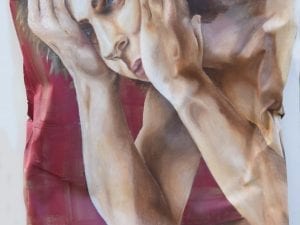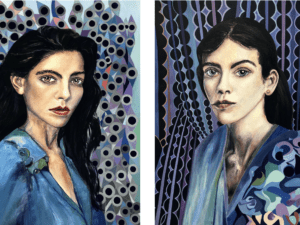Originally from China and based in the USA, Suyu Chen holds an MFA from the Rochester Institute of Technology. Her jewellery and wearable objects are inspired by living in different places and experiencing relationships through the lens of her cultural background. The pieces reveal repetitive experimental explorations of alternative materials such as PVC tubes combined with fine metal practices – resulting in unique forms.
A: In Issue 102 of Aesthetica, we feature a piece from your MFA thesis show. How do you think the presented work encapsulated your MFA?
SC: Throughout the whole of my MFA studies, I was more involved in experimenting with materials that are uncommon in jewellery making, such as canvas and found objects. At the beginning, my focus was directed towards the use of modularity in craft, as well as my Chinese cultural background and experiences. It ended up as an emotional and honest series that related to forms as well as self identity. The work was a summary of my learning experience in the US, and a new beginning for my emerging artistic career.

A: How do you distinguish jewellery from wearable objects?
SC: For me, ‘jewellery’ is a more serious description and form – it sounds like the thing needs to have a clasp, a pin, a chain. But wearable objects can be anything on the body.
A: Why is it important that you create repetitive experimental explorations of alternative materials?
SC: Repetitive practices were a part of my childhood and are a foundation for any career in my culture. I was told that the only way to achieve perfection is to practice again and again. Part of me thinks this is too brutal, and the other part of me has trouble escaping this mindset – because I’ve believed in it for so long. I want to reach the perfection that doesn’t exist.
A: How do these materials, such as PVC tubes, combine with fine metal practices? How do you choose the materials?
SC: I always hunt for materials and objects in local stores. I encountered the PVC tube in a hardware store and was attracted by its matte grey surface. Those daily objects have a weird attraction for me. Maybe it’s the industrial process – based on mathematics and engineering – which brings a perfect balance of forms, colours, textures and weight. I started combining them with cold connection methods such as rivets and tabs, then tried to build up structures with precious metals.
A: To what extent are the materials inspired by living in different places and experiencing relationships through the lens of your cultural background? Or is it about the combination of materials and fine metal practices?
SC: I have a big box of abandoned and broken objects that I collect from thrift stores and a garbage bin near my school’s studio. I enjoy exploring local materials and assembling them into a complete piece. I do this through the lens of my experience and the perspective of a ‘foreigner’. My previous art training in China emphasised repetitive exercises in pursuit of perfection. I want to do more improvisational work with local materials, and to break out of this habit and my comfort zone.
A: How does the lens of your cultural background shape your work?
SC: I am from China. There are lots of theories and philosophies about forms and chaos which influence me a lot. The modularity system in creating art can be found in crafts exported to Europe hundreds of years ago, even in the writing of Chinese characters. I don’t use symbolic and cultural patterns, but I believe that all these methods and philosophies are deeply rooted in my mind. They have shaped my works in a subtle way as well. However, I believe I was shaped and affected by the community where I live; I cannot represent all of Chinese culture.
A: The process of creating a piece involves numerous steps in planning and execution – tell me about these.
SC: I cut and combine the pipes randomly, fill and form them with resin clay; then apply multiple paints such as gesso or enamel paint on the surface. I then sand each layer of paint until a subtle texture appears. The metal part is shaped by forging and soldering. The finished piece is assembled by resin or cold connections, such as rivets.
A: How does the use of muted hues inform your pieces? When is the use of a bright colour important to a piece?
SC: Maybe because the weather here near Ontario Lake is too cold and cloudy. The colours I see are dull. Probably when I move to a warmer place, the colours in my work will be rich.
A: How has your work evolved over time spent at the Rochester Institute of Technology? To what extent do you think you have evolved alongside your work?
SC: During my studies in China, I was more focused on – or my teachers were more focused on – the use of techniques and traditions. During my MFA studies at RIT, it was difficult for me to get rid of my previous working method and try new things in a foreign land. As I make more work, I am becoming more and more confident and open-minded. I am still eager to learn new skills, but at the same time I am more aware of how to use them to express emotions and stories.

A: You participated in the Penland Winter Residency – how was this experience different from the educational institutions you have attended over the years?
SC: It was an inspired experience because I saw different works from artists of various ages, lifestyles and backgrounds. That is something you can’t learn in academic life. They came to this residency with different purposes: some wanted to create a set of work in a short time period, some just wanted to escape from the city. But they all loved and focused on what they were doing. Penland is on a mountain top in North Carolina, and the community is very artistic. It was a great pleasure to live and work with such a solid group of people in the middle of pine trees.
A: You have participated in numerous exhibitions, shows and conferences over the past three years – what learnings and inspiration have you gained from these experiences?
SC: Because of Covid, I haven’t been able to travel overseas and visit exhibitions in person recently, but I have made some friends through social media. I would describe myself a person who is not particularly confident and can be afraid of talking. Attending shows and conferences has pushed me to present myself more to the world. Social media has been a great platform for me as a young artist, but ‘offline’ exhibitions are still important. They offer a true and honest presentation of artwork which cannot be replaced by the internet.
A: How do you think your practice will evolve over the next five years?
SC: I dream of having a big studio and making large scale pieces.
The work of Suyu Chen appears in the Artists’ Directory in Issue 102 of Aesthetica. Click here to visit our online shop.
All images courtesy Suyu Chen.








